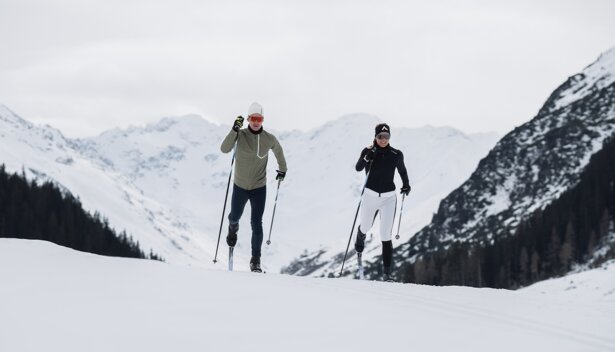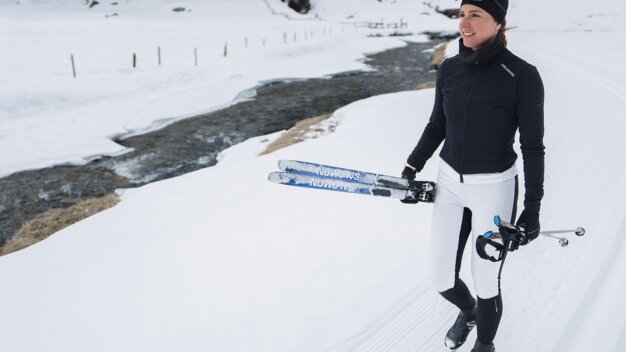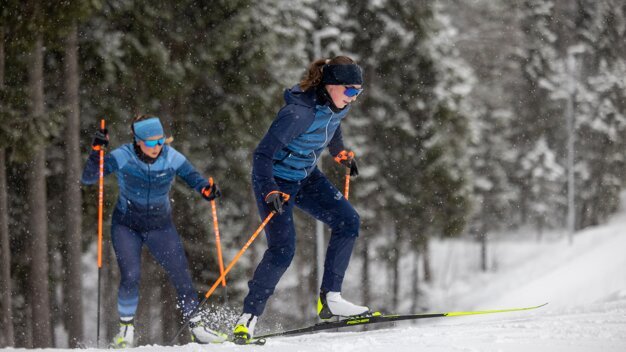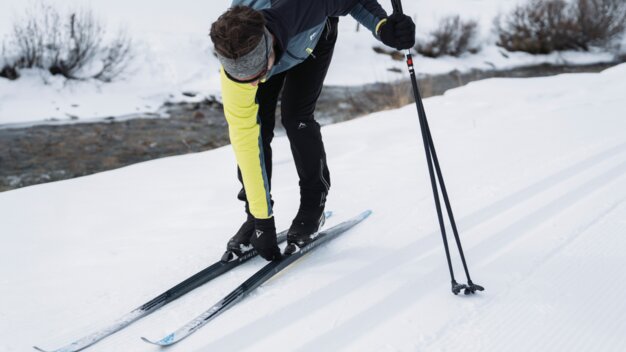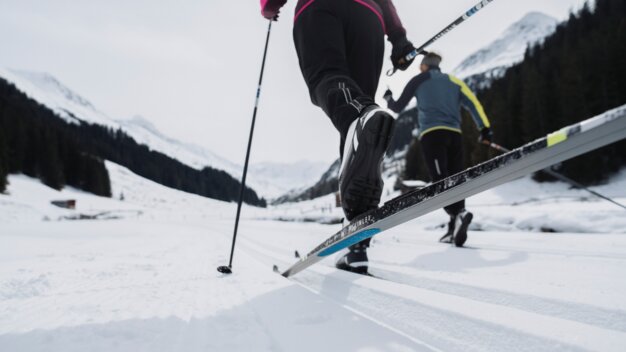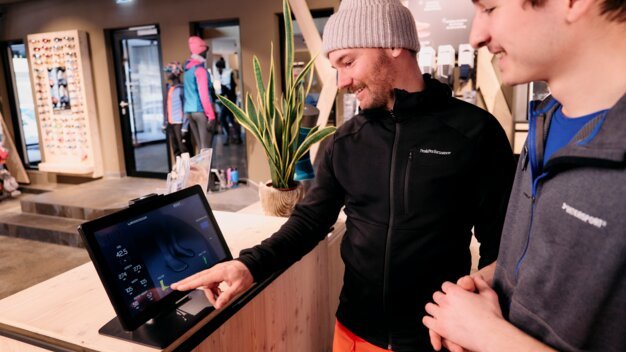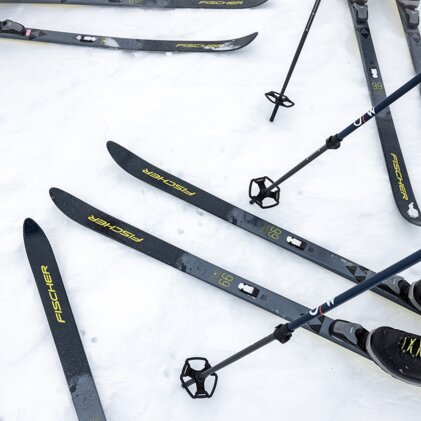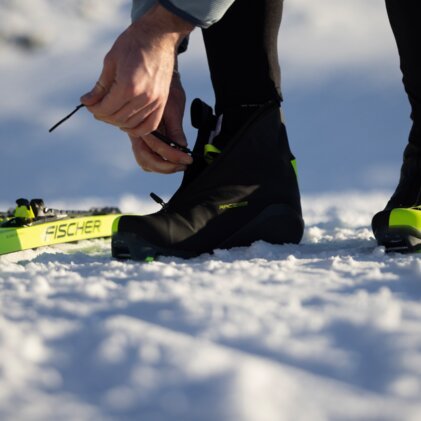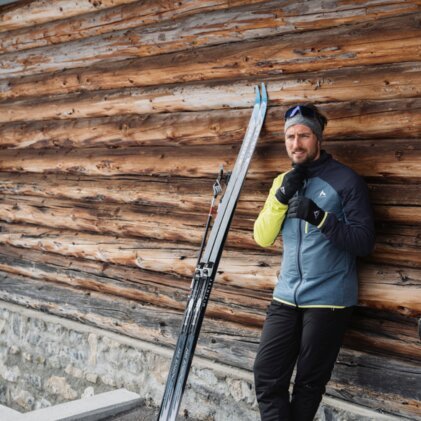
The cross-country ski binding has an important job: it connects your boots to the cross-country skis, enabling efficient power transfer from your body to the ski edges.
In the following article, we take a look at the most common binding systems, their features and their compatibility when it comes to boots with other systems. If you are currently in the process of choosing your equipment, you will find some tips here.
What is a cross-country ski binding?
Cross-country ski bindings are an essential part of the right equipment, reliably connecting the boot to the ski. They are designed in a way that only the forefoot is fixed and the heel remains free to allow the typical pushing and gliding motion of cross-country skiing. The bindings consist of a mechanism for holding the toe of the boot, guide rails for stabilisation and a release mechanism and adjustment options. The special feature is that there are different binding systems, which differ in their design and are therefore not always compatible with each other.
Adjustable cross-country ski bindings
Modern cross-country skis are available with special plates (NIS, IFP or PSP) so that the binding systems can be adjusted. This allows their position on the ski to be changed in order to influence certain properties such as gliding or climbing performance. Other, non-adjustable bindings cannot be easily changed after installation. Whether the binding of a cross-country ski can be changed depends on the ski.
What types of cross-country ski bindings are there?
There are various systems for cross-country skis, which differ in their design, functionality and compatibility. The choice often depends on the cross-country skiing style (classic or skating) and the type of boots.
First of all, a binding system that is now rarely used is the 3-pin system. It is still sometimes used by backcountry cross-country skiers. Although the binding is robust and easy to use, it is less precise than newer systems.
The most common variants are:
NNN (New Nordic Norm): for beginners and experienced skiers
NNN cross-country bindings enable easier, more stable and comfortable contact between the boot and the ski. They have a narrow bridge guide and two guide rails. Thanks to their low weight, availability and ease of use, they are particularly suitable for leisure athletes and sporty skiers who value comfort without compromising on performance.
Features:
- A widely used system
- Has two rails in the sole of the boot that click into special guides on the binding
- Offers good power transfer and is standard on many modern cross-country boots
SNS (Salomon Nordic System): for beginners
The SNS binding system features a single wide guide rail under the boot. It also provides great stability and direct power transfer, making it popular with beginners. It is also well suited for classic cross-country skiing.
Features:
- Has a guide rail in which the cross-country boots are attached
- Offers great stability and enables ideal rolling motion of the foot
Prolink: the first choice for racers
The Prolink system from Salomon offers efficient power transfer and a distinctive skiing experience thanks to its flat and direct connection to the ski. Compatible with NNN and Turnamic boots and offering the option of varying the binding position for more grip or better gliding, it is ideal for classic cross-country skiers who value precise control, comfort and flexibility.
Features:
- Has two bars for attachment
- Provides a particularly direct connection between the ski and cross-country boot for precise movement
Turnamic: suitable for all abilities
The Turnamic system allows individual adjustment of grip and glide characteristics thanks to its tool-free, infinitely adjustable binding. They offer classic cross-country skiers in particular optimum comfort, high flexibility and user-friendliness, which is appreciated by beginners and advanced skiers alike.
Features:
- Equipped with two guide rails
- Extremely lightweight and intuitive to use
- Easy to step in and out
Which cross-country ski binding should I choose?
When deciding which cross-country ski binding to choose, you should keep the following aspects in mind:
- The choice of the right cross-country ski binding depends primarily on compatibility with your ski boots, as the sole standard (e.g. NNN, Prolink, Turnamic or SNS) determines which binding can be used.
- Consider which cross-country skiing style (classic or skating) you need the binding for. For the classic style, there are several modern systems such as NNN, Prolink and Turnamic, which are compatible with each other.
- Make sure that the bindings are easy to use without tools, as this ensures a high level of comfort. The SNS system from Salomon is only compatible with SNS soles, but offers exceptional stability for classic cross-country skiing.
- Adjustable bindings are recommended, as changing their position allows you to customise the grip and glide performance.
- Also check for existing mounting rails on the skis to ensure that the selected binding can be mounted without any problems. It is generally worth choosing both as a set to ensure compatibility with common cross-country binding systems.
Our experts at INTERSPORT Rent will be happy to advise you on choosing the right cross-country ski bindings. Visit us in one of our 800 shops worldwide and benefit from the experience of our RENTertainers.
Which binding is compatible with which shoe sole? We'll show you:
| Binding | Sole NNN | Sole SNS | Sole Prolink | Sole Turnamic |
|---|---|---|---|---|
| NNN | Yes | No | Yes | Yes |
| SNS | No | Yes | No | No |
| Prolink | Yes | No | Yes | Yes |
| Turnamic | Yes | No | Yes | Yes |
The right backcountry bindings for cross-country skiing
If you want to venture off the beaten track with your cross-country skis, you need the right binding system. There are basically two types. However, both variants share the following characteristics: they are larger and heavier, but also more robust than normal cross-country bindings.
Clamp and toe bindings (75 mm Nordic standard/75 NN):
- Reminiscent of telemark bindings, they use a metal bar at the tip of the boot that is clamped into the binding.
- High stability despite heavy equipment
- Favours the telemark style
- The matching boot has a special 75 mm sole with wide straps
- Manual locking of the binding
NNN backcountry binding (NNN-BC):
- Further development of the NNN binding
- Wider binding with larger base plate for greater stability on terrain
- Designed for the diagonal technique
- Compatible with cross-country boots with reinforced, grippy soles
In the article on cross-country boots, you can read about what is important when it comes to footwear for use away from secured terrain.
How do you step into a cross-country ski binding?
There may be differences between models depending on the type of binding. However, the basic principle is always the same. Similar to ski touring with a pin binding, the toe of the boot must first lock into place at the designated point. This secures the boot in the binding. The foot can then rotate around the attachment point, enabling the typical cross-country skiing movement. The following steps are necessary:
- In general, place the boot so that the toe (or a special attachment point) clicks into the binding.
- Then press down until you hear a click, which means that the boot is securely attached.
How do you adjust a cross-country ski binding correctly?
Adjusting cross-country ski bindings often requires a special tool or an adjustment device as an accessory. With adjustable bindings, you can change the position on the ski according to your preferences and needs. Please note that this will also influence the gliding and climbing characteristics. Unlike alpine bindings, there is also no automatic release in the event of a fall. Always follow the manufacturer's instructions for specific adjustments!
If you are unsure, you can also use our ski service. Our experts will help you find the right binding settings for your cross-country skiing equipment in one of our over 800 shops.
How do you release yourself from cross-country ski bindings?
To release yourself from the binding, you usually press a lever. Often there is also a tab that you press upwards or pull. This releases the mechanism that holds the boot in place and you can lift your foot out of the binding.
Frequently asked questions about cross-country ski bindings
Is Prolink the same as NNN?
Prolink is based on the NNN standard, which is why both systems are fundamentally compatible with each other. Both versions feature two side guide rails. However, Prolink stands out thanks to its flatter and lighter design. The system also promises a better feel for the snow and more direct power transfer.
How do I know if I have NNN or SNS bindings?
One of the distinguishing features can be seen in the guide rails: NNN bindings have two narrow guide rails, while SNS models have one long bar with a wide metal pin.
What is an IFP binding?
This is a plate integrated into the ski, developed by Fischer and Rossignol, which promises tool-free and flexible adjustability. It also has a rotating mechanism for easier entry and exit and is compatible with Turnamic and NNN bindings. Thanks to various adapters, SNS and Prolink variants can also be mounted.
INTERSPORT Rent tip
The RENTertainer recommends
If you are just getting started with cross-country skiing, it might be a good idea to rent the equipment first – for example, at one of our INTERSPORT Rent shops. This will give you a a good feeling for how the chosen binding affects your performance and you can try out other systems if necessary.
Rent cross-country skiing equipment now
Related articles
You may also be interested in:

